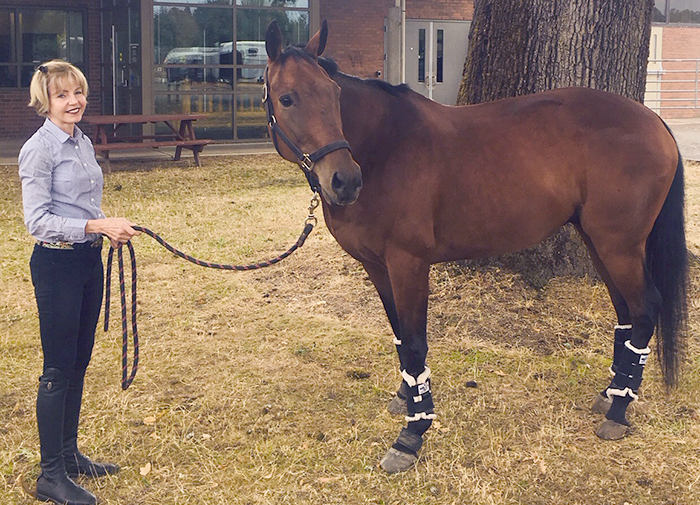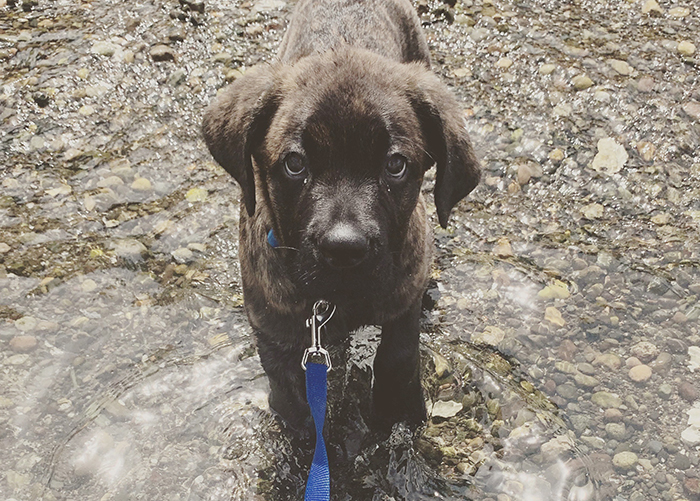Breeds like bulldogs and Pekingese are called brachycephalic dogs; they have skull bones that are shortened in length, giving the face a pushed-in appearance. This characteristic of their anatomy can cause health problems, including respiratory conditions.
Brachycephalic airway syndrome (BAS) refers to a set of upper airway abnormalities that sometimes affect brachycephalic dogs. Mildly affected dogs will have noisy breathing, especially with exercise. Severely affected dogs have more pronounced airway noise, get tired more easily, and may faint after exercise.
In December, a pug was referred to the OSU Veterinary Teaching Hospital (VTH) with shortness of breath. Radiographs showed multiple airway abnormalities, typical of brachycephalic airway syndrome. The owners met with Dr. Lea Mehrkens, a soft tissue surgery resident, to discuss treatment options. They decided to proceed with corrective surgery.
Dr. Katy Townsend, a soft tissue surgeon at the VTH, increased the diameter of the pug’s nostrils, shortened the soft palate, and removed obstructions in the larynx. The pug was then admitted to the Intensive Care Unit (ICU).
Dr. Tandi Ngwenyama is head of the critical care team in the ICU. She works with a group of interns, residents, and highly-skilled veterinary technicians to monitor and care for patients recovering from surgery, or with other life-threatening conditions.
The ICU team closely monitored the patient during her recovery from surgery and noticed she was still having trouble breathing due to post-surgery swelling. Dr. Ngweyama consulted with the surgeon, discussed different options, and decided to proceed with a temporary tracheostomy.
Back in ICU, following the tracheostomy, Dr. Ngwenyama developed a new plan for the pug’s care. It included continuous checking for airway and tube obstructions, and monitoring for comfort.
“She spent three weeks with us and we got very attached to her. One of our goals is to make the ICU as positive an experience as we can for the patient. She is a sweet, loving dog so we were very happy that the outcome was good.”
Dr. Ngwenyama is new to the critical care service at the VTH. “I am excited to join the leadership team,” she says. “Technician supervisor Julie Posch has done an amazing job; we have similar philosophies and vision for the ICU.”
One of Dr. Ngwenyama’s first objectives was to work with the ICU team to write a new mission statement: The SA ICU team demonstrates compassionate care, and strives for excellent patient care while fostering a positive teaching and learning environment for all faculty, staff and students.
“Now we want to make sure that we live up to it; that our actions, thoughts and words are consistent with what are values are,” says Dr. Ngwenyama. “We want to actually walk our talk.”
To that end, the group decided to make real changes that will improve communication, particularly in daily rounds. “Because we work 24/7 and have shift changes,” says Dr. Ngwenyama, “rounds are very important for communicating with the next group of people. That is when we discuss the status of the patient and our goals for their care.” The ICU team is working on a more structured approach to rounds to make them more effective. “We want them to be clear, concise, and complete.”
Another goal for the ICU team is to add the practice of debriefing. “I think it is very important with high intensity cases, or if you, unfortunately, have a poor outcome,” says Dr. Ngwenyama. “We need to meet as a group, for even five or ten minutes, to debrief. For example, we had a CPR case and unfortunately could not get spontaneous return of circulation. There were a number of people and services involved: certified technicians, house officers, students, the anesthesia service and internal medicine. At the debrief, it was so great to meet and follow a structure: we did a quick synopsis, then talked about what did well, and what we could have done better.”
Dr. Ngwenyama also thinks it is important to create an environment where everyone can have a voice. “It needs to be a flattened hierarchy where not only doctors can speak,” she says. “Everyone’s perspective is important.”




